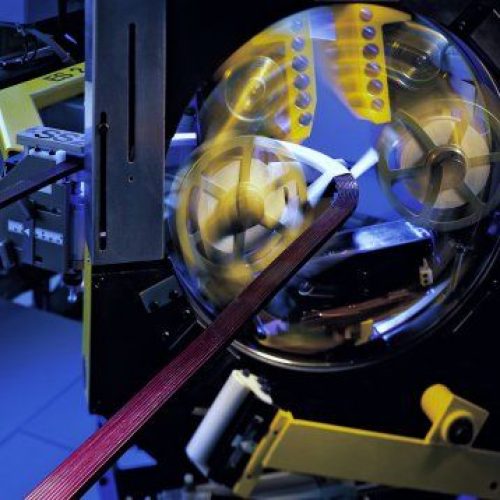Among many tasks conducted by the production services, the most important ones are planning and monitoring of its processes. The latter task is associated with the registration of material and workflows through workstations. Depending on the needs, the production performance is recorded on subsequent or selected technological operations. The detailed recording depends on information needs, technical capabilities related to registration of production as well as the costs of the registration compared to the value of the information obtained this way.
Until recently, detailed records of the flow of work-in-progress were limited by technical capabilities of the SAP system. It was possible to receive the entire production performed on a production order in reserved, smaller units and record them with accuracy to the nearest batch of material. Many companies take advantage of this option by accepting a single ordered amount of product batches associated with standard containers (or pallets), a shift or a working day, etc.
In a more complex process requiring a number of technological operations, precise tracking of such smaller units of the flowing material was not possible. There was a kind of a “black hole” between the batches of the consumed components and the batches of products received from the order. It was possible to only repeatedly register partial quantities of the produced pieces, kilograms, meters (or other units of measurement) of the work-in-progress, without the possibility to link such partial quantities in the flow from operation to operation. Also, it was not possible to describe such partial quantities in more detail, for example, by using the characteristicsof classification.

Stephan Model, “Phoenix" Project Leader, Von Roll
Consistency and functionality are at the forefront
The purpose of this major project called “Phoenix" for the implementation and execution of SAP rollouts in the company Von Roll is to develop such system model that will support all major areas of the company. The provision of a reliable management information starting with the highest level of data aggregation and support of complex production and logistics processes in one uniform system is a tremendous challenge for our company.
We operate in the strategic energy sector and run several independent business units, each of which is characterized by a separate management and sales specifics. We also have several specialized production facilities in different countries.
Translated into the IT language, this means the need to develop a strategy to support hundreds of business processes in a system template. The consideration of interests, needs and expectations of users from different organizational levels and at the same time focusing on the targeted consistency and functionality of the implemented solutions is one of the main tasks of the Project Management Committee. The introduction of solutions outside the system standards in an already complex business environment is always associated with additional costs and project challenges. However, the key factor is to achieve potential business benefits. For this reason, we at Von Roll use the experience of BCC experts in order to use our systems as efficient as possible.
Stephan Model, “Phoenix" Project Leader, Von Roll
Work-in-progress batch
The SAP’s response to the shortage of information is the functionality of work-in-progress batches (WIP batches), already introduced a few years ago. It allows registering partial quantities produced in successive technological operations with a reference to the WIP batch number. The completion confirmation of successive technological operations is carried out in the quantities corresponding to the unit of the flowing material and a batch number identifies every such unit. Such batches can be split or merged forming a network of connections that in a precise manner presents the material flow within one multi-operational production order.
Each batch may be described by the use of classification charateristics. WIP batches are created for the reference material, which is assigned to the material in the order header in its basic data. Posting the movement of materials of the receipt and consumption is done with the use of dedicated types of movements, and the reserve of WIP batches is a blocked reserve.
Production of copper wire
The need to use the WIP batch management functionality emerged in a project implemented at Von Roll, having its registered office in Switzerland. Von Roll is a provider of products made of copper (wires, enamelled and coated with mica tape), mica tapes and composites mainly for the power industry. It has its manufacturing facilities in Switzerland, Germany, France, Great Britain, Italy, Brazil, India, China and the United States. It is the supplier for such global companies as Siemens and Alstom.
WIP batches have been used in the production of copper wire. Each reel of wire manufactured in the operations of drawing, rolling, enamelling, coating with tape, etc. is identified by a batch number. The reels in subsequent operations may be split into smaller ones, the wire may also be collected (merge) from a number of smaller reels, winding it onto a bigger one.
The solution developed by SAP assumes an integration of a WIP batch with the confirmation of the operation in the so-called time ticket variant and thus the total quantity manufactured and the changeover, machinery and personal times are recorded. Any and all information is entered in a much modified transaction CO11N (confirming a single operation) where appear a number of new icons used to define the split, merge of batches, define the component batch links with WIP batches and the latter with the product batches.
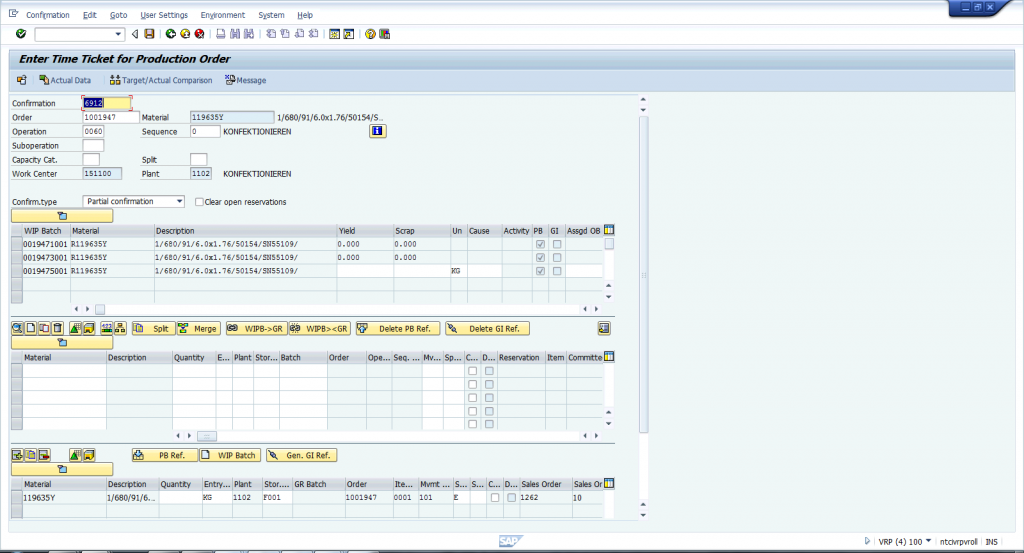
SAP – original screen display to confirm a single operation
Customer’s specific requirements
Meanwhile, Von Roll’s needs turned out to be different. It was necessary to substantially modify the SAP standard. On its basis, BCC consultants created a proprietary solution enabling full control of a WIP batch in accordance with the customer’s requirements. The practice prevailing at Von Roll is to confirm time events: start and finish of the setup and the start, interruption and finish of the processing. The sequence of activities about to be performed is strictly defined and so now the operator has only such activities displayed, which are required by the logic of activities performed by them, for example, it is only possible to start processing after declaring the finish of the changeover and after the start of processing it is only possible to interrupt it and its partial or complete finish.

Emmanuel Chatzinakis, Senior IT Project Manager, Strategic Projects, Von Roll
Detailed level of informationin SAP
Precise information about the material flow in production is very important for Von Roll, both for the observance of delivery to the customer, as well as for the accurate assessment of the value of work in progress. Copper prices, which are often subject to fluctuations, have a significant share of the cost at Von Roll. In our business we need to know exactly how much of the raw material, when purchased and at what price, is engaged in work in progress and what were the costs of raw materials in the products sold. Such detailed information was a request from the management of Von Roll with regard to the SAP implementation project.
The proposed solution of the BCC (now All for One Poland) consultants in connection with the registration of each roll of wire at each stage of the production process, including the identification of the proportion of pure copper, enables compliance with the operational requirements. At the same time, this solution can be easily operated by the system users in the production hall.
As an IT Project Manager, I believe that the balance between the expectations of business and the cost of their preparation and the subsequent operation is one of the biggest challenges in creating SAP standard supporting solutions. In this case, I can say that this goal has been achieved.
Emmanuel Chatzinakis, Senior IT Project Manager, Strategic Projects, Von RollMoreover, it was also needed to integrate the system with the weights from which the gross weights were read and after declaring the type of reel, the net weight of the wound wire was determined. The user interface was adapted to the company’s needs reducing unnecessary options and icons and leaving only those that were used for the registration of manufactured reels of wire in a specific phase of operation. In fact the transaction is dynamically adapting to the current confirmation status so that it is not possible to make a confirmation that is incompatible with the current situation.
Each weighed reel receives a printed label with its identification data such as material, batch numbers and net and tare weights. The bar code on the label accelerates the recording and release to the next production phase. As it often is the case that a few reels are registered in a row, each label can be printed directly after weighing or together after the registration is complete. Below is an overview diagram of individual steps of operation of the application for production confirmation.
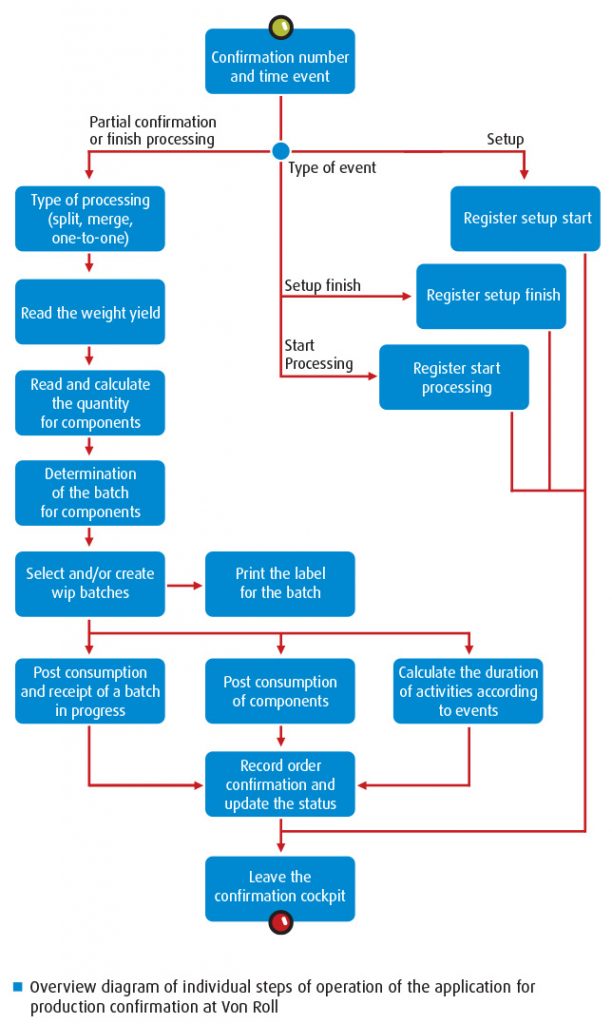
Ergonomics and functionality on a single screen
In the application, which supports the confirmation of production, a number of features greatly simplify the work and shortens the time required for efficient production confirmation have been implemented. Among other things these are:
- Automatic reading of the order components assigned to a confirmed operation,
- Automatic calculation of the proposed quantity of components consumption based on the yield read from the interface, taking into account the declared scrap,
- Automatic batch determination at the stage of reading the components and calculation of their quantity,
- Automatic calculation of the duration time of particular activities for the production confirmation based on the registered time events, these are in particular: Setup, Machine time, Labor time,
- Automatic classification of the produced batches in progress and the finished product,
- Automatic check of the tolerance of the total yield weight of the batch in progress in terms of the total batch weight consumed during confirmation.
In order to maximally facilitate the work of machine operators the application has been designed as a single screen application. In addition, such a cockpit design for confirmations limits operator errors to a minimum while working with WIP confirmations. Below is the design, functionality and ergonomics of the screen application.
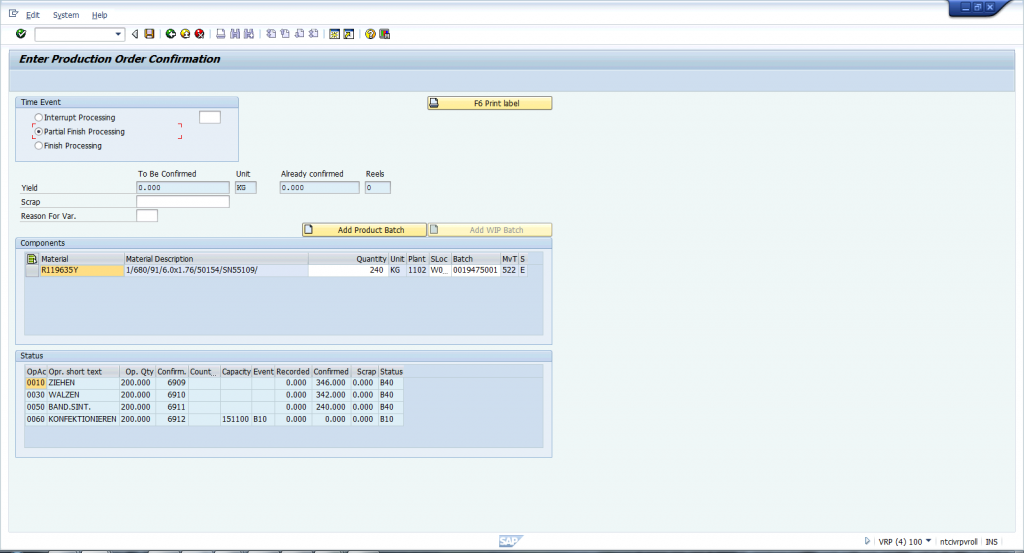
Single screen for production operation confirmation (BCC solution for Von Roll)
Batch merging, splitting and processing
Posting the receipts of new reels from a technological operation is carried out with reference to the reels used up in the process of splitting or merging and created in the previous operation. The diagram below shows examples of possibilities to process raw materials and WIP batches in order to produce batches of finished products with full traceability (possibility to trace the entire process “backwards”). As shown in the diagram the example uses all the options for batch processing: combining multiple batches into one (merge), dividing one batch in many (split) and processing a batch into a batch (one-to-one).
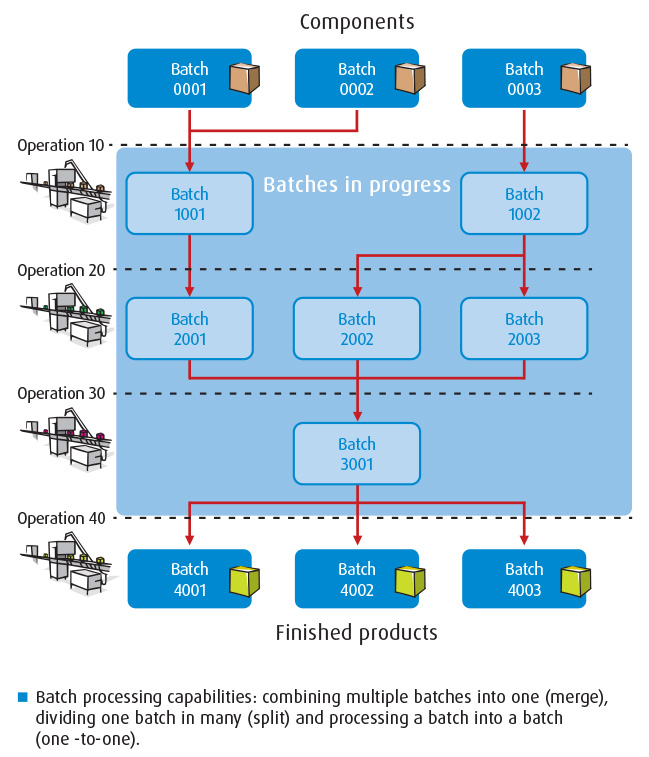
Thanks to such an approach the history of production of each reel (WIP batch) is known precisely and it can be traced using the standard SAP report. It looks a lot like the known for years Batch Cockpit displaying the use of material batches. The screen can show the history of production of raw material batches, WIP batches created in subsequent technological operations up to a batch of a product accepted from the order to the warehouse in both directions, i.e., top – down (from the product to raw material) and bottom – up (from the raw material to the product).
The proprietary application of BCC has been upgraded with a report displaying all activities carried out on each operation in the production order, including the events that did not result in posting production materials or times.
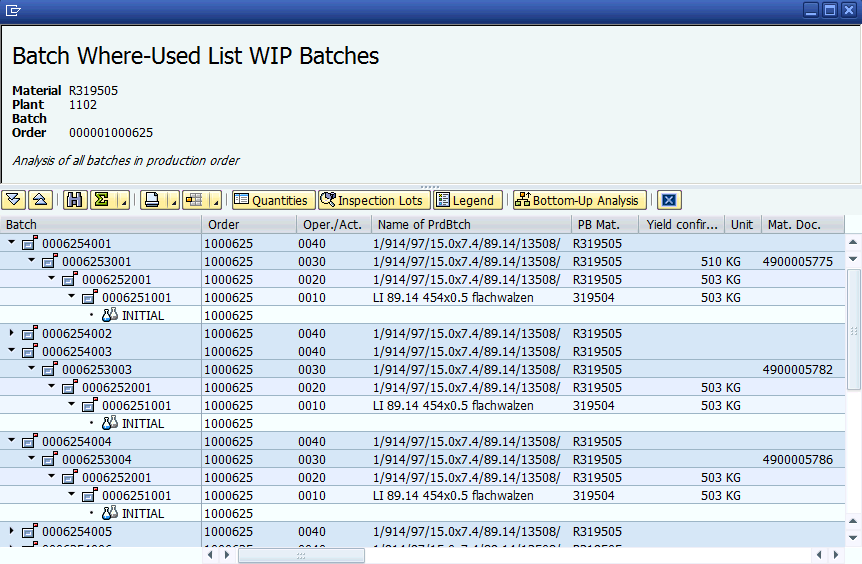
A report that trace WIP batches within production order
Detailed control of material flow in the production process
As mentioned at the beginning of this article, the decision of a more detailed registration of the material flow is usually dictated by the relation of the cost of obtaining additional information to its managerial value. At Von Roll, apart from the described above, WIP batches carry additional information – the percentage of the share of pure copper in a product manufactured in each operation. Because the wire is coated with enamel or mica tape the registered weight of the product is not identical with the weight of pure copper. Copper as a strategic raw material is controlled in a specific manner. The information contained in the classification of a WIP batch is used to analyze the value of copper involved in the current production.
WIP batch management functionality meets the requirements of all those companies which, due to legal, environmental, quality requirements associated with the realisation of products responsible for the safety of users (use of the equipment subject to technical inspections) or associated with the needs of cost accounting, must register the material flow in the production process in greater detail.
Technical implementation of these solutions in SAP may require additional programming work as the standard does not always meet the requirements of the users. One should also expect higher than before labour-intensiveness of the recording process. The solution proposed by BCC at Von Roll after three months of use may be considered accepted not only by persons to whom it provides managerial information but also by direct operators from whom it requires a greater amount of work. It is also a good basis for integration with the quality control module, which previously operated by an external system and is expected to be implemented in the next SAP development phase.


